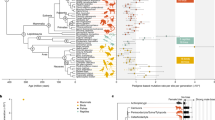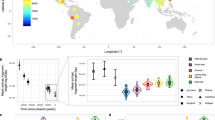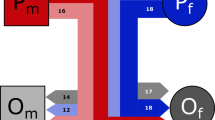Abstract
Studies of human genetic diseases have suggested a higher mutation rate in males than in females1 and the male-to-female ratio (α) of mutation rate has been estimated from DNA sequence and microsatellite data to be about 4–6 in higher primates2,3,4,5. Two recent studies, however, claim that α is only about 2 in humans6,7. This is even smaller than the estimates (α > 4) for carnivores and birds8,9; humans should have a higher α than carnivores and birds because of a longer generation time and a larger sex difference in the number of germ cell cycles. To resolve this issue, we sequenced a noncoding fragment on Y of about 10.4 kilobases (kb) and a homologous region on chromosome 3 in humans, greater apes, and lesser apes. Here we show that our estimate of α from the internal branches of the phylogeny is 5.25 (95% confidence interval (CI) 2.44 to ∞), similar to the previous estimates2,3,4,5, but significantly higher than the two recent ones6,7. In contrast, for the external (short, species-specific) branches, α is only 2.23 (95% CI: 1.47–3.84). We suggest that closely related species are not suitable for estimating α, because of ancient polymorphism and other factors. Moreover, we provide an explanation for the small estimate of α in a previous study12. Our study reinstates a high α in hominoids and supports the view that DNA replication errors are the primary source of germline mutation.
This is a preview of subscription content, access via your institution
Access options
Subscribe to this journal
Receive 51 print issues and online access
$199.00 per year
only $3.90 per issue
Buy this article
- Purchase on Springer Link
- Instant access to full article PDF
Prices may be subject to local taxes which are calculated during checkout


Similar content being viewed by others
References
Crow, J. F. The origins, patterns and implications of human spontaneous mutation. Nature Rev. Genet. 1, 40–47 (2000).
Huang, W., Chang, B. H.-J., Gu, X., Hewett-Emmett, D. & Li, W.-H. Sex differences in mutation rate in higher primates estimated from AMG intron sequences. J. Mol. Evol. 44, 463–465 (1997).
Agulnik, A. I. et al. Evolution of the DAZ gene family suggests that Y-linked DAZ plays little, or a limited, role in spermatogenesis but underlines a recent African origin for human populations. Hum. Mol. Genet. 7, 1371–1377 (1998).
Nachman, M. W. & Crowell, S. L. Estimate of the mutation rate per nucleotide in humans. Genetics 156, 297–304 (2000).
Ellegren, H. Heterogeneous mutation processes in human microsatellite DNA sequences. Nature Genet. 24, 400–402 (2000).
Bohossian, H. B., Skaletsky, H. & Page, D. C. Unexpectedly similar rates of nucleotide substitution found in male and female hominids. Nature 406, 622–625 (2000).
International Human Genome Sequencing Consortium. Initial sequencing and analysis of the human genome. Nature 409, 860–921 (2000).
Pecon Slattery, J. & O'Brien, S. J. Patterns of Y and X chromosome DNA sequence divergence during the Felidae radiation. Genetics 148, 1245–1255 (1998).
Ellegren, H. & Fridolfsson, A. K. Male-driven evolution of DNA sequences in birds. Nature Genet. 17, 182–184 (1997).
Shimmin, L. C., Chang, B.H.-J., Hewett-Emmett, D. & Li, W.-H. Potential problems in estimating the male-to-female mutation rate ratio from DNA sequence data. J. Mol. Evol. 37, 160–166 (1993).
Saxena, R. et al. Four DAZ genes in two clusters found in the AZFc region of the human Y chromosome. Genomics 67, 256–67 (2000).
Miyata, T., Hayashida, H., Kuma, K., Mitsuyasu, K. & Yasunaga, T. Male-driven molecular evolution: a model and nucleotide sequence analysis. Cold Spring Harbor Symp. Quant. Biol. 52, 863–867 (1987).
Begun, D. J. & Aquadro, C. F. Levels of naturally occurring DNA polymorphism correlate with recombination rates in D. melanogaster. Nature 356, 519–520 (1992).
Charlesworth, B. & Charlesworth, D. The degeneration of Y chromosomes. Phil. Trans. R. Soc. Lond. B 355, 1563–1572 (2000).
Li, W.-H. Distribution of nucleotide differences between two randomly chosen cistrons in a finite population. Genetics 85, 331–337 (1977).
Erlandsson, R., Wilson, J. F. & Paabo, S. Sex chromosomal transposable element accumulation and male-driven substitutional evolution in humans. Mol. Biol. Evol. 17, 804–812 (2000).
McVean, G. T. & Hurst, L. D. Evidence for a selectively favourable reduction in the mutation rate of the X chromosome. Nature 386, 388–392 (1997).
Xia, X. Data Analysis in Molecular Biology and Evolution (Kluwer Academic, Boston, 2000).
Tajima, F. & Nei, M. Estimation of evolutionary distance between nucleotide sequences. Mol. Biol. Evol. 1, 269–285 (1984).
Felsenstein, J. PHYLIP—Phylogeny Inference Package (version 3.2). Cladistics 5, 164–166 (1989).
Acknowledgements
The DNA samples were purchased from San Diego Zoological Society and the gibbon sample was given by M. Jensen-Seaman. We thank J. Crow and D. Page for comments. This study was supported by NIH grants.
Author information
Authors and Affiliations
Corresponding author
Ethics declarations
Competing interests
The authors declare that they have no competing financial interests
Supplementary information
Rights and permissions
About this article
Cite this article
Makova, K., Li, WH. Strong male-driven evolution of DNA sequences in humans and apes. Nature 416, 624–626 (2002). https://doi.org/10.1038/416624a
Received:
Accepted:
Issue Date:
DOI: https://doi.org/10.1038/416624a
This article is cited by
-
Adult stem cell activity in naked mole rats for long-term tissue maintenance
Nature Communications (2023)
-
Reproductive genetics and the aging male
Journal of Assisted Reproduction and Genetics (2018)
-
Multicopy gene family evolution on primate Y chromosomes
BMC Genomics (2016)
-
Meiotic Pairing Inadequacies at the Levels of X Chromosome, Gene, or Base: Epigenetic Tagging for Transgenerational Error-Correction Guided by a Future Homologous Duplex
Biological Theory (2016)
-
Initiation of recombination suppression and PAR formation during the early stages of neo-sex chromosome differentiation in the Okinawa spiny rat, Tokudaia muenninki
BMC Evolutionary Biology (2015)
Comments
By submitting a comment you agree to abide by our Terms and Community Guidelines. If you find something abusive or that does not comply with our terms or guidelines please flag it as inappropriate.



